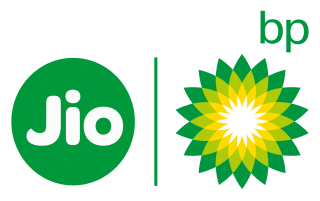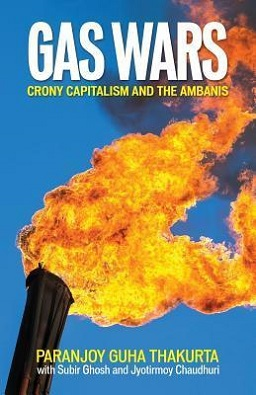
Reliance Industries Limited is an Indian multinational conglomerate, headquartered in Mumbai. Its businesses include energy, petrochemicals, natural gas, retail, telecommunications, mass media, and textiles. Reliance is the largest public company in India by market capitalisation and revenue, and the 100th largest company worldwide. It is India's largest private tax payer and largest exporter, accounting for 7% of India's total merchandise exports. The company has relatively little free cash flow and high corporate debt.

Dhirajlal Hirachand Ambani was an Indian businessman who founded Reliance Industries in 1958. Ambani took Reliance public in 1977. In 2016, he was honoured posthumously with the Padma Vibhushan, India's second-highest civilian honour for his contributions to trade and industry. Ambani faced numerous accusations of market manipulation, tax evasion, and cronyism.

Mukesh Dhirubhai Ambani is an Indian-Gujarati billionaire businessman. He is currently the chairman and managing director of Reliance Industries, India's most valuable company by market value. With an estimated net worth of $91.2 billion as of August 2023, he is the richest person in Asia and 13th richest in the world. Sometimes characterized as a plutocrat; he has attracted both fame and notoriety for reports of market manipulation, political corruption, cronyism, and exploitation. Time magazine listed him as one of the 100 most influential people of 2019, under the "Titans" section.

Anil Dhirubhai Ambani is an Indian businessman chairman and managing director of Reliance Group. The Reliance Group was created in July 2006 following a demerger from Reliance Industries Limited. He lead several stocks listed corporations including Reliance Capital, Reliance Infrastructure, Reliance Power and Reliance Communications.

Tina Ambani is a former Indian actress. She is married to Anil Ambani, chairman of Reliance Group. She is actively involved in many foundations and charities. Many of these were established in the memory of her in-laws, Dhirubhai and Kokilaben Ambani. Her work ranges from elder care to promotion of Indian art.
Bombay Dyeing & Manufacturing Company Limited is the flagship company of the Wadia Group, engaged primarily in the business of Textiles. Bombay Dyeing is one of India's largest producers of textiles.

Jio-bp, or legally Reliance BP Mobility Limited, formally known as Reliance Petroleum is an Indian petroleum company that specializes in oil and energy, owned by Mukesh Ambani of Reliance Industries Limited (RIL), one of India's largest private sector companies. It is based in Ahmedabad, Gujarat, India and has interests in the downstream oil business. RPL was merged with Reliance Industries Limited on 29 September 2009.
Nitish Kumar Sengupta was an Indian academician, administrator, politician and author.
Network18 Media & Investments Limited, commonly referred to as the Network18 Group and sometimes as the Network18–Eenadu Group, is an Indian media conglomerate owned by the energy giant Reliance Industries, headed by billionaire Mukesh Ambani. Rahul Joshi is the managing director, chief executive officer and group editor-in-chief of Network18, and Adil Zainulbhai is the chairman of its board of directors.
Reliance Anil Dhirubhai Ambani Group or popularly known as Reliance ADA Group or simply Reliance Group is an Indian conglomerate, headquartered in Mumbai, India. The company, which was formed after Dhirubhai Ambani's business was divided up, is headed by his younger son Anil Ambani. Reliance Group has five listed companies, Reliance Power, Reliance Infrastructure, Reliance Capital, Reliance Home Finance and Reliance Health. The group provides financial services, construction, entertainment, power, health care, manufacturing, defence, aviation, and transportation services.
Anand Jain is an Indian business executive. He is the Chairman of Jai Corp Limited. He has 30 years of experience in various businesses, with an expertise in real estate, finance and capital markets and often considered as third son of Dhirubhai Ambani
Reliance Power Limited (R-Power), formerly Reliance Energy Generation Limited (REGL) is a part of the Reliance Anil Dhirubhai Ambani Group. It was established to develop, construct, operate and maintain power projects in the Indian and international markets. Reliance Infrastructure, an Indian private sector power utility company and the Reliance ADA Group promote Reliance Power. The present CEO of Reliance Power is K. Raja Gopal since 2 May 2018.
Hamish McDonald is an Australian journalist and author of several books. He held a fellowship at the American think tank the Woodrow Wilson Centre in 2014.
Manohar J. Pherwani was an Indian corporate executive and banker who served as Chairman of the Unit Trust of India (UTI), National Housing Bank (NHB) and Infrastructure Leasing & Financial Services (IL&FS). Under his tenure of almost a decade as the chairman of UTI, the asset base of UTI grew from ₹1 billion to about ₹176.5 billion.
Tonse Ananth Pai, was an Indian banker and politician, who was responsible for the success of Syndicate Bank as its general manager and later as chairman. He is also the founder of T. A. Pai Management Institute.

Lalit Jalan is the Advisor & former Chief Executive Officer of Reliance Infrastructure, part of the Reliance Anil Dhirubhai Ambani Group (ADAG), one of India's largest corporate houses. He is the Chairman of BSES Rajdhani Power Limited and BSES Yamuna Power Limited and serves as Director in several companies including Reliance Defence Ltd, which is associated with the Rafale deal between India and France.

Gas Wars: Crony Capitalism and the Ambanis is a book written by Indian journalists Paranjoy Guha Thakurta, Subir Ghosh and Jyotirmoy Chaudhuri. The book was officially released on 15 April 2014. The book deals with the issue of irregularities in the determination of the price of natural gas in India.

Nita Mukesh Ambani is an Indian philanthropist. She is the chairperson and founder of the Reliance Foundation, Dhirubhai Ambani International School and a director of Reliance Industries. She is married to Reliance Industries chairman and managing director Mukesh Ambani. With a family fortune estimated in excess of US$83.4 billion, the Ambanis are among the richest in the world. She is also an art collector and the owner of the Indian Premier League cricket team Mumbai Indians.

Sue the Messenger: How legal arm-twisting by corporates is shackling reportage and undermining democracy in India is a book written by Subir Ghosh, with Paranjoy Guha Thakurta. The book was released at a gathering in New Delhi on 4 May 2016.
The Dhirubhai Ambani Green Energy Giga Complex is a mega project being developed by Reliance Industries in Jamnagar, Gujarat, India. This is a fully integrated renewable energy manufacturing complex that will build gigafactories for photovoltaic panels, energy storage, green hydrogen, electrolyzers and fuel cells systems. The complex is being built on a 5,000 acres site and is expected to cost ₹75,000 crores. The first phase of the project, which includes the construction of a 20 GW solar photovoltaic module factory, is expected to be completed by 2023, 5 GWh annual cell to pack manufacturing facility by 2024, and further scale up to 50 GWh & 100 GWh annual capacity by 2027 & 2030. It is one of the largest renewable energy projects in the world. It is expected to play a major role in India's transition to a clean energy future.











